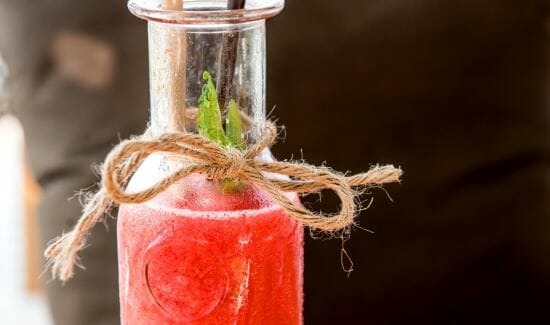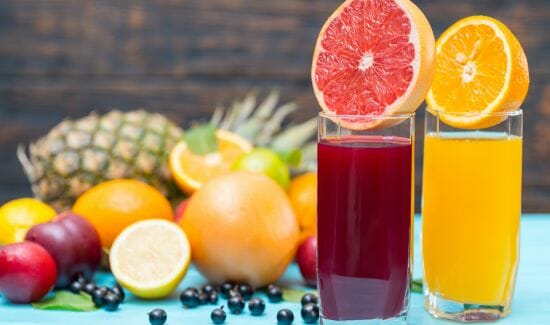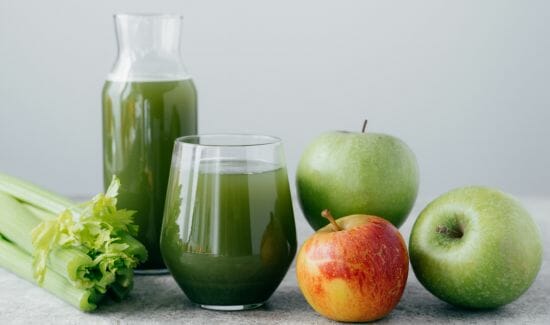
In the quest for a healthier lifestyle and enhanced nutrition, the choice between juicing and blending has become a common dilemma. Both methods offer unique benefits, but they also come with their share of drawbacks.
If you’re wondering which path is right for you, this guide is here to help you navigate the juicy waters of choice. We’ll explore the nutritional nuances, health considerations, taste and texture differences, and more to equip you with the knowledge needed to make an informed decision.

Benefits and Drawbacks of Juicing:
Benefits of Juicing:
Juicing has surged in popularity for several reasons. Here, we delve into the benefits:
- Nutrient Extraction: One of the primary advantages of juicing is the efficient extraction of nutrients from fruits and vegetables. Through the juicing process, you can obtain a concentrated elixir of vitamins, minerals, and antioxidants that your body can quickly absorb.
- Hydration Boost: Fresh fruit and vegetable juices are a delicious way to stay hydrated, particularly for those who may not be fond of plain water. The added bonus is that you’re hydrating while nourishing your body.
- Detoxification: Juicing is often associated with detox regimens. The abundance of antioxidants in fresh juices can support the body’s natural detoxification processes, leaving you feeling revitalized.
- Weight Loss: For those on a weight loss journey, juicing can be an ally. Low in calories and high in nutrients, it can help you shed those extra pounds when incorporated into a balanced diet.
- Vibrant Skin and Hair: The nutrient-rich concoctions you create can contribute to glowing skin and healthy hair. The vitamins and antioxidants found in juices can promote a youthful appearance.
Drawbacks of Juicing
Now, let’s discuss some of the challenges and drawbacks associated with juicing:
- Fiber Reduction: The juicing process often removes the fiber from fruits and vegetables. While this allows for efficient nutrient absorption, it means missing out on the valuable dietary fiber that supports digestion.
- Quick Oxidation: Fresh juices are best consumed immediately to prevent oxidation, which can lead to a reduction in nutrient content and flavor.
- Sugar Content: Some fruit juices can be high in natural sugars, potentially impacting blood sugar levels if consumed in excess.
- Equipment and Cleanup: Juicing can be a bit of an equipment-intensive process, and cleanup can be time-consuming.

Benefits and Drawbacks of Blending:
Benefits of Blending:
Blending, often associated with smoothies, offers its own set of advantages:
- Fiber Retention: Unlike juicing, blending retains the fiber from fruits and vegetables. This fiber promotes a feeling of fullness, aids digestion, and supports a steady release of nutrients into the bloodstream.
- Texture and Taste: The thick, creamy texture of smoothies can be quite satisfying, making them a delightful treat. You can also incorporate a variety of ingredients to create diverse flavor profiles.
- Sustained Energy: The balanced combination of nutrients and fiber in blended drinks can provide a gradual release of energy, keeping you feeling full and energized for longer.
- Customization: Blending allows for endless customization. You can tailor your smoothies to meet your specific nutritional needs and taste preferences.
Drawbacks of Blending:
However, blending is not without its limitations:
- Volume: Blended drinks tend to have a larger volume due to the retained fiber, which may not be ideal for those seeking a quick, concentrated nutrient boost.
- Nutrient Dilution: The fiber in smoothies can dilute the nutrient concentration compared to juices, potentially requiring larger servings to achieve the same nutrient intake.
- Texture and Consistency: Some individuals may find the texture or thickness of smoothies less appealing than the clarity of juices.

Nutritional Comparison:
Juicing vs. Blending Nutrition:
Now that we’ve taken a closer look at the benefits and drawbacks of juicing and blending, let’s delve into the nutritional comparison. This section will help you understand how the nutrient content of juices and smoothies stack up against each other.
When it comes to nutrition, juices are prized for their ability to provide a concentrated source of vitamins and minerals. The juicing process separates the liquid from the fiber, allowing for rapid nutrient absorption. On the other hand, blending retains the fiber, offering the benefits of sustained energy and digestive support.
For those seeking a quick nutrient infusion, juicing might be the preferred choice. However, it’s important to note that the absence of fiber in juices can lead to quicker sugar absorption, making them less suitable for individuals with certain dietary concerns.
In contrast, smoothies shine in their ability to deliver both nutrients and fiber in one package. This fiber content promotes feelings of fullness and steady energy release. It also helps regulate blood sugar levels.
The choice between juicing and blending may depend on your individual health goals and dietary preferences. The nutritional comparison is just one aspect to consider when making your decision.

Health and Weight Loss Considerations:
If you’re exploring juicing and blending with health and weight loss in mind, it’s essential to understand how each method may impact your goals.
Juicing is often embraced for its potential to support detoxification, thanks to the high concentration of antioxidants in fresh juices. It can be a valuable addition to a holistic approach to health. However, it’s important to consume a balanced diet alongside juicing to meet all your nutritional needs. For weight loss, juicing can serve as a low-calorie, nutrient-rich option. It helps control calorie intake while delivering essential vitamins and minerals.
Blending, particularly in the form of smoothies, offers a sustainable approach to weight management. The fiber in blended drinks promotes a feeling of fullness, reducing the temptation to snack between meals. It also helps with digestive regularity.

Taste and Texture Differences:
As you consider the choice between juicing and blending, one key factor to take into account is taste and texture.
Fresh juices, with their clarity and absence of fiber, often offer a clean, crisp taste. They’re a great choice for those who appreciate the purity of individual ingredients.
Smoothies, on the other hand, provide a creamy, thick texture. This texture can be quite satisfying and may appeal to those who enjoy a heartier drink.
The taste and texture of your chosen method are closely linked to personal preference. Whether you savor the crisp notes of fresh juices or the lush creaminess of smoothies, your palate will guide you in your choice.

Juicing and Blending Success Stories:
To provide you with real-world insights into the effectiveness of juicing and blending, let’s explore some success stories and case studies.
Case Study 1: Jenna struggled with her weight and was looking for a solution that would kickstart her health journey. She turned to juicing and, over the course of a few months, lost a significant amount of weight. With regular green juice consumption and a balanced diet, Jenna transformed her life.
Case Study 2: Alex had a busy lifestyle and often skipped meals. He incorporated nutrient-rich smoothies into his daily routine. Not only did he find that his energy levels improved, but he also shed those extra pounds. Smoothies provided a convenient and nutritious option for him.
These real-life examples demonstrate that both juicing and blending can be effective tools for achieving health and wellness goals. The key is to find the method that aligns with your unique needs and preferences.
Conclusion:
In our journey through the world of juicing and blending, we’ve explored the benefits, drawbacks, and nutritional nuances of each method. We’ve considered the impact on health, weight management, taste, and texture preferences. Real-life success stories have shown that both methods can yield transformative results when embraced in the right context.
As you make your choice between juicing and blending, remember that it’s a decision that should align with your individual needs and goals. There’s no one-size-fits-all answer. What’s most important is finding a method that fits seamlessly into your lifestyle and brings you closer to your health and wellness objectives.
FAQs:
Which is better for weight loss: juicing or blending?
Both can support weight loss. Juicing is low in calories, while blending provides a feeling of fullness.
Do I lose fiber when juicing?
Yes, the juicing process removes fiber, which is retained in blended drinks.
Are there specific health benefits to juicing?
Juicing can provide a concentrated source of nutrients and antioxidants, supporting overall health.
What about the sugar content in juices?
Some fruit juices can be high in natural sugars. It’s important to consume them in moderation.
Do smoothies keep me full for longer?
Yes, the fiber in smoothies can promote a feeling of fullness, making them a good choice for sustained energy.
Which is more convenient, juicing, or blending?
Blending is often more convenient as it doesn’t require immediate consumption, and cleanup is simpler.

As a dedicated blogger, I share insights, tips, and knowledge on all things caffeinated and beyond. I firmly believe that a well-brewed cup of coffee or a skillfully crafted cocktail has the power to unite people and ignite engaging conversations.


